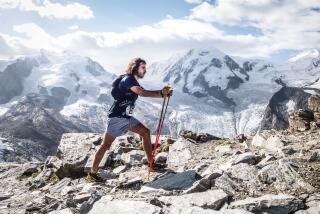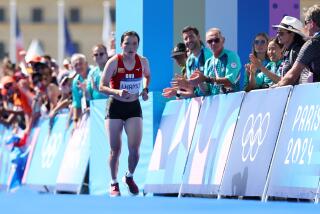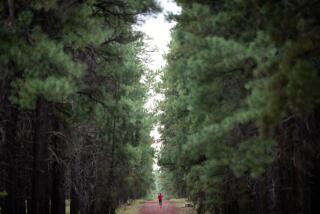On Dashers! To the Top of the World
Apple Valley doctor Vir Nanda is a marathoner 10 times over, pounding over routes in Athens, Arizona and elsewhere. But this year, Nanda’s skipping those balmy locales for something, well, a little cooler.
Come Saturday, the San Bernardino County oncologist will be one of seven Americans running the North Pole Marathon. More than 50 extreme marathoners will cover 26.195 miles in snowshoes across a 6- to 12-foot-thick sheet of frozen Arctic Ocean. For fun. At 15 below.
Nanda’s been dragging himself out of bed at 4:30 a.m. to train in the Mojave Desert scrub and, on occasion, plodding through his grassy backyard in lightweight snowshoes.
He’s shelled out the $10,000 entrance fee for outrageous adventure.
“It’s a once-in-a-lifetime experience,” said Nanda, 52, who will take a Russian cargo plane from a Norwegian island outpost to the northernmost spot on the globe.
Irishman Richard Donovan pioneered the concept in April 2002, running solo in aimless circles at 90 degrees latitude with a global positioning gadget in hand to measure his distance. He was eager to conquer the North Pole after he had one of the top finishes in the first-ever South Pole Marathon earlier that year.
After the run, Donovan realized that his one-man North Pole expedition might have mass appeal.
Nanda read about the cold-weather race in Runner’s World magazine and was hooked. After a brief stop in Scandinavia, the doctor will haul a rolling suitcase crammed with $2,000 of cold-weather gear to the Arctic Circle.
Runners wear three sets of thin polyester shirts and pants and will triple-layer gloves and socks. Nanda’s heavy-duty anti-freeze goggles are outfitted with tiny fans that blow hot air to defog them. They fit over the black ninja mask that will cover Nanda’s nose and mouth to protect against frostbite.
Nanda, the lone Californian in the race, has never tried on the whole bulky get-up.
“Even thinking about it creates a lot of heat,” Nanda said.
He trains mostly on Apple Valley’s dusty desert roads, running about 60 miles a week, with occasional early-morning visits to Big Bear to practice dashing through the snow.
The doctor registered for last year’s race, which was scuttled at the last minute due to a dispute between logistics companies from France and Russia operating expeditions to the pole. (All trips to the pole were dashed that year, Donovan said.)
Nanda’s wife, Urmila Nanda, 50, is less enthusiastic than he is: “I don’t want him to go; I’m scared,” said Urmila Nanda, 50. But, she said, her husband is “very determined.”
The runners will fly to the marathon’s circular route at 89 degrees latitude, about 60 miles from the pole.
The course isn’t laid out at the exact North Pole, so that ice breaks and floating ice floes -- which would be perilous for runners and could send portions of the track drifting away -- can be avoided.
Contestants will run eight laps of just over three miles apiece on a solid sheet of ice where Donovan can monitor the group through binoculars and a snowmobile will trail them. A circular track is the best option, Donovan said, because on a straight route there would be a greater risk of encountering a crack in the ice.
Could the frozen ocean split open under a runner’s feet?
“Very, very unlikely,” Donovan said. “The perceived risks are greater than the actual risks.”
Competitors will pile out of the plane, spend a few hours preparing in a heated tent at the Russian base camp, and then start the first of eight laps shortly after midnight, illuminated by 24-hour sunshine.
Donovan wants the quick start to serve as a “real shock treatment” to competitors. “There’s no point hanging around,” he said. Helpers will provide runners with water from a checkpoint tent along the route.
The group, which includes running champions and total newcomers, will then fly by helicopter to the exact top of the world, for pictures and souvenir bottles of snow.
Finishing times for 2004’s crop of about 16 marathoners ranged from less than four hours to about 20 hours for one man who took a nap to escape the intense chill.
This year’s participants come mostly from Great Britain, including one 66-year-old woman, said Donovan, 39, a former economist who has run an ultramarathon, a race longer than the regulation marathon, on every continent and lives in Galway, Ireland. But compared with the South Pole, at about 10,000 feet, a sea-level Arctic run is a breeze, Donovan said. The best race conditions they can hope for? Minus-15 degrees Fahrenheit with no wind.
The event’s April date comes during the Arctic’s five-week window of daylight, probable clear weather, warmer temperatures and solid ice.
The men’s and women’s winners will receive a $5,000 extreme-weather watch; every runner goes home with a medal, a T-shirt, a patch, a certificate and a photo CD of the group in action.
After nearly two years of waiting, Nanda is ready to run. His family, which is Hindu, had “Krishna” embroidered on one of Nanda’s jackets so the god would be with him along the snowy path. Nanda is packing his favorite homemade Indian sweets his wife baked just for the trip north.
“Life is experiences anyway,” said Nanda, trim and soft-spoken. “The running is such a passion, such a pleasure,” even spiritual, he said.
Next, he said, he’s tackling the Great Wall of China.
More to Read
Sign up for The Wild
We’ll help you find the best places to hike, bike and run, as well as the perfect silent spots for meditation and yoga.
You may occasionally receive promotional content from the Los Angeles Times.






